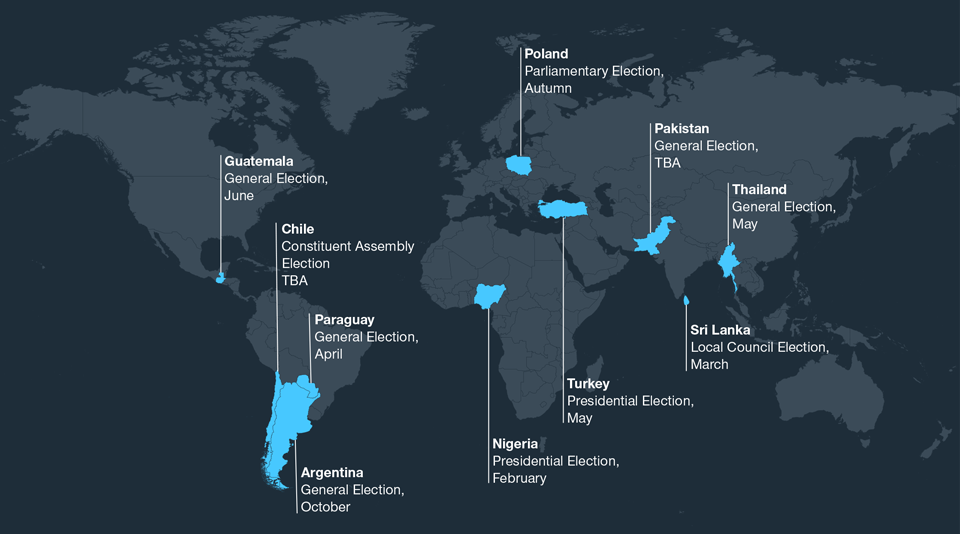March 2023 / INVESTMENT INSIGHTS
2023—A Year of Transition for Emerging Markets
China reopening supportive, but not enough on its own
Highlights
- China reopening: Activity in China has fallen during the reopening, echoing the experiences of Hong Kong and Taiwan, but a rebound will likely follow. The extent of the rebound will depend on the consumption and property market recoveries.
- Geopolitics: The war in Ukraine remains at a stalemate, and we expect this to continue for the foreseeable future. There are several key elections to monitor this year, including those in Poland, Thailand, and Turkey.
- Growth and fiscal: With the exception of China, we expect growth to slow this year in emerging markets (EM), given the lagged impact of past tightening and the likelihood of falling goods demand from developed markets. However, emerging markets may be poised to outperform developed markets.
- Monetary policy and inflation: EM central banks started raising interest rates earlier than their developed market counterparts and are therefore further progressed in their hiking cycles, with several either close to the peak or finished. Interest rate cuts are being priced in, although we feel this is a little premature unless there is a deep economic slowdown.
- Rates, credit, and currencies: With inflation rolling over and central bank rates peaking, the outlook for local rates is compelling. EM currencies also look attractively valued, but direction could be dictated by the U.S. dollar.
Emerging markets (EM) are in a state of transition this year as they work through the structural shocks left by the coronavirus pandemic and Russia’s invasion of Ukraine. It’s been a strong start so far thanks to China’s reopening and markets pricing in the goldilocks scenario of declining inflation and a soft landing. But given how difficult this benign outcome is to achieve, risks remain, in our view. How this all plays out over the next few months will likely have important implications for how EM assets perform in 2023.
China Reopening
China’s economy is reopening and at a much faster pace than anticipated. As expected, economic activity has initially been disrupted, as it was in Hong Kong and Taiwan when they lifted restrictions from a similar starting point. After this initial fall, however, economic growth should rebound; but to what extent depends on the recovery in consumption. While savings are high, the government has provided relatively modest consumer stimulus relative to other countries, and confidence remains an unknown coming out of the pandemic. While we are reasonably constructive on the outlook, the rebound will likely be initially oriented toward domestic services. We expect the reopening to lead to some inflation in China as domestic demand recovers, although lower commodity price pressures and slack in the labor market will likely temper the rise.
As the global economy was only moderately impacted by China’s zero‑COVID policy, the positive impact of China’s reopening will also likely be moderate. Representing around 15% of world gross domestic product,1 China will struggle to change the global trajectory on its own, but it could help to temper this year’s expected slowdown. The spillover benefits from China’s reopening are very specific, with increased commodity demand likely, particularly in oil and gas. There could also be increased demand for other imports and the potential for a positive tourism impact for the Asia region, with Thailand being seen as a key beneficiary.
The net effect of China’s reopening on global inflation is complicated by the weak growth outlook. We believe the main potential spillover is via the commodity channel. However, if the global slowdown outweighs the positive impulse from increased Chinese demand for commodities, then the effect is likely to be less disinflation rather than more inflation at the headline level.
Geopolitics
The war in Ukraine remains at a stalemate, which we expect will continue for the foreseeable future. It remains a risk for emerging markets, and any sign of escalation or a new spillover to energy supplies could negatively impact investor sentiment within the asset class.
On the domestic side, key elections are due to take place in Poland, Thailand, and Turkey, and there will be a new election in Chile for a constituent assembly. In Thailand, the general election slated for May is set against a backdrop of a constitution that favors the ruling establishment but may signal broader social discontent and demand for change. Meanwhile, Turkey’s presidential election is scheduled to take place in mid‑May but there is a possibility of a delay following the devastating earthquakes that struck the country. When it does take place, the election should be closely watched as it could be a pivotal moment for Turkey’s sociopolitical and economic policies. In Poland, parliamentary elections are expected in the autumn and are likely to feature a contest between a pro‑European Union (EU) opposition and the nationalist governing coalition, which has been in conflict with the EU on a number of issues.
Overview of EM Election Landscape in 2023
Elections can test the confidence of markets and provide insights into policy direction.

As of January 31, 2023.
Election dates are provisional and may be subject to change. Analysis by T. Rowe Price.
In frontier markets, elections are scheduled in Argentina, Pakistan, Nigeria, Paraguay, and Guatemala. Sri Lanka will also hold local elections, which will likely be an early test of the new president. Meanwhile, Venezuela’s opposition will hold primaries that may result in a more cohesive leadership that engage in negotiations.
Growth and Fiscal
With the exception of China, we expect growth to slow this year in emerging markets, given the lagged impact from past tightening and the likelihood of falling developed market goods demand for EM exports. However, the downturn is likely to be milder than developed markets, so EM economies may be poised to outperform, which opens up the potential for a positive differential on the Purchasing Managers’ Index (PMI) side. Within emerging markets, we expect open economies to largely follow developed markets lower. Closed and more commodity‑based economies appear to be holding up better so far. China’s reopening should be supportive for Asia, although many Asian countries would be exposed negatively to a sharper fall in developed markets goods demand.
On the fiscal front, positions have broadly been improving on revenue gains, but deficits remain somewhat elevated versus pre‑pandemic levels. Debt levels have stabilized but will struggle to come down further, given the softening growth outlook and higher cost of capital. Substantial external imbalances built up in the first half of last year, in part reflecting the energy shock but also the strong domestic demand in a range of countries. Trade deficits are starting to stabilize and improve at the margin, while slowing growth should help to resolve some of these external imbalances.
Monetary Policy and Inflation
Central banks in emerging markets started raising rates earlier than developed markets and are therefore further along in their hiking cycles, with several either close to the peak or finished. Against this backdrop, the focus is now on the sequencing—how long central banks will keep rates on hold before moving to cutting cycles. Broadly, we feel interest rate cuts are unlikely this year unless there is a global recession that prompts the Federal Reserve to cut rates.
Regarding inflation, upstream pressures are rolling over in line with oil, while food prices are also starting to show signs of moderation. PMI prices generally indicate a further downside in sequential inflation, although they are still at the high end of their pre‑pandemic range. The pace of disinflation is coming through strongest in Brazil and Chile at the core level. Central and Eastern Europe is seeing the least decline in sequential core inflation, although this could pick up if energy price declines can sustain. Wage pressures appear to be highest in this region, however.
Rates, Credit, and Currencies
The outlook for local rates is compelling, in our view, with central bank rates peaking and a mix of tailwinds supporting the disinflation theme. This includes energy crisis fears subsiding, food supply normalizing, and growth indicators showing signs of slowing. The lagged impact from monetary tightening should also start to feed through and be supportive. But in countries where there’s high wage growth, particularly in Central and Eastern Europe, inflation could stay elevated for longer. Broadly, we expect inflation to settle at a relatively high level versus history. Elsewhere, valuations continue to be supportive, with bond yields at some of their highest levels for over a decade.
The outlook is also constructive in the EM credit sphere, but we are mindful of shrinking valuations and the potential for pullbacks if a soft landing is in doubt. The asset class has enjoyed a strong rally so far this year, supported by China’s reopening and a loosening of U.S. financial conditions. Inflows have been strong and EM issuers have used the better market environment to front-load their borrowing for the year. But valuations look mostly squeezed out of the higher-quality segment of the market. Therefore, we expect an increasing amount of the return in the asset class to be driven by the more distressed parts where credit selection will play an important role.
For EM currencies, we expect disinflation to be a supportive factor this year. Valuations also remain broadly attractive, although recent strength has led to a select few currencies approaching expensive levels, namely the Mexican peso and Czech koruna. Momentum has been swinging against the U.S. dollar lately, and there are rising expectations that we are at a medium-term inflection point after years of considerable strength. We remain cautiously optimistic on this front but mindful that a recession-like scenario could support the dollar.
IMPORTANT INFORMATION
This material is being furnished for general informational and/or marketing purposes only. The material does not constitute or undertake to give advice of any nature, including fiduciary investment advice, nor is it intended to serve as the primary basis for an investment decision. Prospective investors are recommended to seek independent legal, financial and tax advice before making any investment decision. T. Rowe Price group of companies including T. Rowe Price Associates, Inc. and/or its affiliates receive revenue from T. Rowe Price investment products and services. Past performance is not a reliable indicator of future performance. The value of an investment and any income from it can go down as well as up. Investors may get back less than the amount invested.
The material does not constitute a distribution, an offer, an invitation, a personal or general recommendation or solicitation to sell or buy any securities in any jurisdiction or to conduct any particular investment activity. The material has not been reviewed by any regulatory authority in any jurisdiction.
Information and opinions presented have been obtained or derived from sources believed to be reliable and current; however, we cannot guarantee the sources' accuracy or completeness. There is no guarantee that any forecasts made will come to pass. The views contained herein are as of the date noted on the material and are subject to change without notice; these views may differ from those of other T. Rowe Price group companies and/or associates. Under no circumstances should the material, in whole or in part, be copied or redistributed without consent from T. Rowe Price.
The material is not intended for use by persons in jurisdictions which prohibit or restrict the distribution of the material and in certain countries the material is provided upon specific request.
It is not intended for distribution to retail investors in any jurisdiction.
March 2023 / INVESTMENT INSIGHTS

